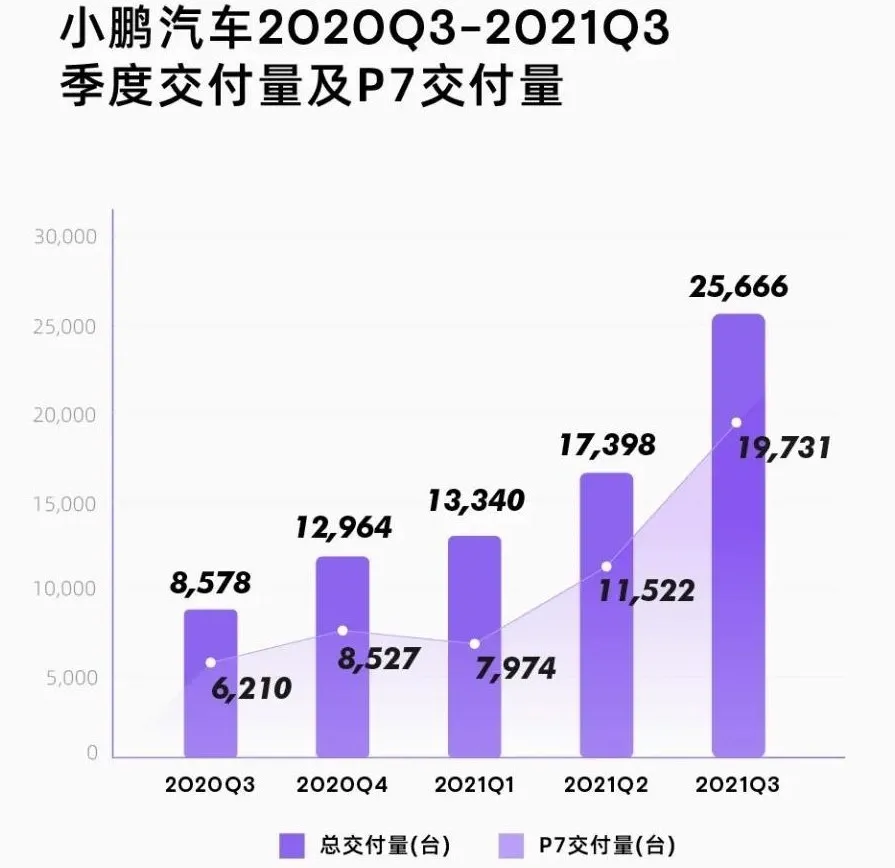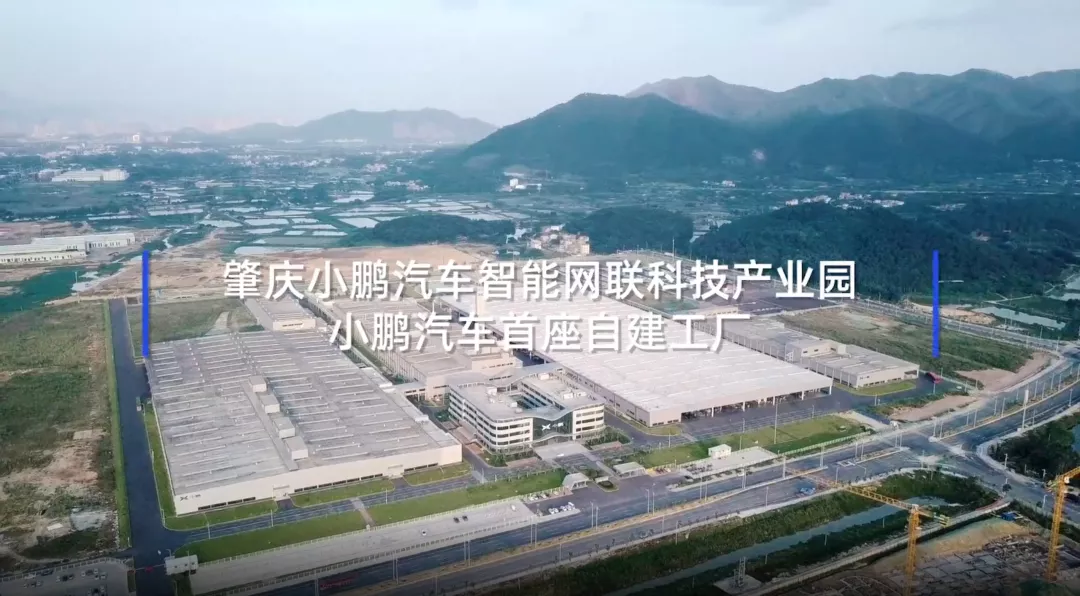Author: Xiaodong
The Guangzhou International Auto Show officially opened on November 19th. On the same day, XPeng’s flagship SUV, the XPeng G9, made its debut. Four days later, XPeng released its Q3 2021 financial report. This quarter’s report had many eye-catching highlights, such as a 52.1% increase in revenue, rapid expansion of sales outlets and supercharging stations, and an estimated delivery of 34,500-36,500 vehicles in Q4.
During the Q3 earnings conference, He XPeng also revealed many important pieces of information, including XPeng’s medium and long-term plans, Robotaxi, globalization, and the delivery time of the G9.
The full text contains a lot of relevant information and a high density of information. Enjoy!
Flagship SUV
The introduction of the XPeng G9 has added many labels to XPeng.
As XPeng’s future flagship model, the G9 has put a lot of effort into its hardware. The G9 will be the first production model in China based on the 800V high-voltage SiC platform, and before this, the only car model based on the 800V platform was the Porsche Taycan.
It’s well known that the biggest advantage of 800V is that the charging speed will be greatly improved. Limited by the positioning and corresponding holding capacity of the Porsche Taycan, the number of 800V supercharging stations that can meet the requirements in China is very limited. However, the G9 can achieve significant improvements to this problem.
At the XPeng Tech Day on October 24th of this year, XPeng officially announced its 480 kW high-voltage supercharging pile. The car’s end can achieve a peak charging current of more than 600A, and the output current of the pile end can reach 670A. With the high voltage and large current solution, the XPeng G9 can achieve a range of 200 kilometers with a 5-minute charge.
During the earnings conference, He XPeng also revealed that apart from newly-built supercharging stations, 480 kW supercharging piles will also gradually replace the old piles at existing charging stations and transition from 180 kW to 360 kW – 480 kW.
Researching and developing something similar to 480 kW supercharging piles is by no means an easy task. There are essentially only two ways to increase the charging power: increase the voltage and increase the current.Using Tesla’s V3 supercharging station as an example, the peak power of V3 supercharging station can reach 250 kW, and it may reach 360 kW in the future. Tesla currently uses a 400V platform, and the only way to achieve such high charging power is to increase the current. However, one of the reasons why few automakers use high current to enhance charging power is the issue of heat management.
For example, although the Taycan uses an 800V platform, its peak charging power is only 270 kW. Increasing the current is not an easy task. High voltage has also become the preferred option for more automakers, such as the BYD Han, which is based on a 600V platform.
The high-voltage platform and supporting charging pile of the Xpeng G9 are just one of its advantages. Xpeng also adopts a new generation of electronic and electrical architecture X-EEA 3.0 on the G9. The core of X-EEA 3.0 is the hardware architecture of central supercomputer + regional control. Simply put, it integrates various modules of the car and uses higher computing power chips for centralized calculation. This includes chassis, power, intelligent cockpit, intelligent driving and other domains.
In terms of software, the vehicle-level hierarchical software platform architecture of the X-EEA 3.0 electronic and electrical architecture defines the entire vehicle software through system software platform, basic software platform, and intelligent application platform. The advantage of this is that it can more quickly iterate intelligent functions. At the same time, Xpeng G9 also achieved the first gigabit Ethernet backbone communication architecture in China, which makes the vehicle faster in data transmission and supports intelligent driving and intelligent cockpit functions based on a large amount of data transmission.
Finally, let’s talk about XPILOT 4.0, which will be installed on the Xpeng G9. Intelligent driving has always been Xpeng’s proud area. Since the excellent performance of the XPLIOT 2.5 installed on the Xpeng G3, which integrates parking, entered the public view, Xpeng has become more outstanding in intelligent driving. Xpeng P7 equipped with XPLIOT 3.0 launched the NGP function of high-speed navigation assistance in January this year, which can achieve intelligent driving according to navigation on high-speed/high-level roads. In Xpeng P5, which was just delivered and equipped with XPLIOT 3.5 (to be released in the first quarter of next year), it realizes urban navigation assistance (NGP).According to He XPeng’s remarks at the Q3 financial report conference, XPILOT 3.5 can only cover certain roads in certain cities. In the era of XPILOT 4.0, the goal is to expand intelligent driving to cover more travel scenarios and move towards globalization (Europe will be promoted). However, unfortunately, XPILOT 3.5 cannot be upgraded to XPILOT 4.0. Constrained by computing power, perception systems, and the aforementioned electronic and electrical architecture, XPILOT 4.0 has improved its computing power to 508 TOPS, far higher than the current P7 and P5’s 30 TOPS. At the same time, algorithms such as ACC, LCC, and APA will be rewritten in XPILOT 4.0, further improving the user experience.
At the financial report conference, He XPeng revealed that the XPeng G9 will begin deliveries in the third quarter of next year. So, are you tempted by this good-looking car with a high-voltage platform, a brand new electronic and electrical architecture, and better intelligence in the G9?
Highlights of the Financial Report
After discussing XPeng’s new car, let’s get back to this financial report. XPeng’s third-quarter financial report for 2021 can be said to be very impressive, with total revenue reaching 5.72 billion, an increase of 52.1% compared to the previous quarter, and deliveries of 25,666 vehicles, an increase of 47.5% compared to the previous quarter, with 19,731 P7s delivered.

In XPeng’s forecast for the fourth quarter, it is estimated that deliveries will reach between 34,500 and 36,500 vehicles, with total revenue between 7.1 billion and 7.5 billion. Looking only at vehicle deliveries, the average monthly delivery volume reached 12,000 vehicles. We already know that the delivery volume in October was 10,138 vehicles, which means that XPeng will deliver more than 25,000 vehicles in November and December combined, which also reflects the improving supply chain situation for XPeng.

According to He XPeng’s remarks at the financial report conference, XPeng’s P5 orders need to be completed after the Spring Festival, which means that production capacity is still limiting XPeng’s delivery volume. At the same time, the production line for the G3i has been moved to the Zhaoqing factory. Nowadays, the Zhaoqing factory adopts double shifts of 20 hours per day, and the production capacity is climbing. Therefore, completing the target of 36,000 vehicles should not be a problem. Don’t forget that XPeng also has a monthly delivery target of 15,000 vehicles.Let’s take a look at some basic data. In Q3 of this year, XPeng’s gross profit margin reached 14.4%, an increase from Q2’s 11.9%. Of course, this cannot be compared to Tesla’s terrifying 28.4% gross profit margin. However, after entering the high-end market, XPeng’s gross profit margin is expected to further increase.
In July of this year, XPeng Automobile was officially listed on the Hong Kong Stock Exchange, which also made XPeng’s funds more abundant. As of September 30, 2021, XPeng’s cash reserves reached RMB 45.36 billion.
In terms of spending, XPeng’s R&D expenses in Q3 reached RMB 1.2642 billion, a staggering increase of 46.4% QoQ. The main reason is the increase in R&D personnel, related software development, and the R&D of P5 and G9. Currently, XPeng’s R&D team has also reached 4,000 people. In addition, sales and general administrative expenses reached RMB 1.5384 billion, an increase of 49.3% QoQ, mainly due to the increase in marketing and advertising expenses, as well as the related costs of expanding the sales network.
With a significant increase in investment, let’s take a look at the results. As of September 30, 2021, XPeng has 271 sales outlets covering 95 cities, and 439 supercharging stations covering 121 cities. Looking back at the data for the previous quarter, there were 200 sales outlets and 231 supercharging stations. In other words, the coverage of supercharging stations almost doubled in just one quarter.
In the future, high-quality supercharging stations will undoubtedly become one of the factors that consumers consider when choosing a brand, especially since XPeng is about to expand its layout on the 480 kW charging pile. At the same time, XPeng’s layout of supercharging stations on highways has also made it more convenient for more car owners. This year, XPeng is expected to exceed 600 supercharging stations, and will sign contracts to build them in all prefecture-level cities in China. By 2022-2023, most county-level cities and highways will also be covered.During the current conference call, He XPeng revealed one of XPeng’s longer-term plans, the Robotaxi. XPeng plans to start exploring Robotaxi in the second half of 2022, using XPeng’s mass-produced car models. He XPeng stated that from a hardware perspective, XPeng’s Robotaxi will be cheaper than other companies currently operating Robotaxis. Currently, data shows that Robotaxis can travel 8,000 to 10,000 kilometers per month. More data will help XPeng make faster progress in intelligent driving while verifying the software algorithm, reliability, and safety.
He XPeng also stated that XPeng’s Robotaxi is more about improving the capabilities of XPILOT 4.0 and even 5.0, verifying the closed-loop capability of software and hardware. XPeng does not intend to be an operator in the transportation industry but wants to work with partners to provide better travel experience. Currently, Robotaxi is still in internal communication and initial framework.
In addition, He XPeng also explained XPeng’s internationalization, and the XPeng G9 will also become a vehicle model launched globally by XPeng. In terms of country selection, in addition to G3 and P7 being listed in Norway, XPeng will expand into other countries including Sweden, the Netherlands, and Denmark in the future. From 2020 to 2022, XPeng will mainly establish a foundation for internationalization, including hardware research and development, safety and data protection, software research and development, and international team building. From 2023 to 2025, XPeng will enter the global market and first enter Europe.
XPeng’s Q3 financial report performance can be considered very impressive, and Robotaxi and internationalization have also made XPeng popular in the capital market.
Conclusion
Today, XPeng’s infrastructure is rapidly expanding, and production capacity is increasing, laying the foundation for future internationalization. The XPeng G9 is equipped with a high-voltage platform, a new electronic architecture, and higher-level intelligent driving. This also means that as He XPeng said, XPeng Automobile will rely on differentiation to enter the high-end market. The XPeng G9, which will be launched next year in the third quarter, is highly anticipated.
This article is a translation by ChatGPT of a Chinese report from 42HOW. If you have any questions about it, please email bd@42how.com.